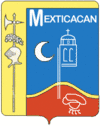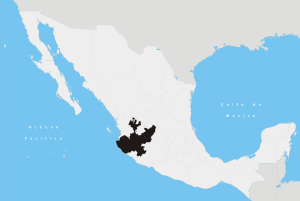Mexticacan
Mexticacán is a town and municipality in the Southern Zone of Los Altos Region of Jalisco. Mexticacán comes from the Nahuatl language and means "place where the temple for the worship of the moon".
Mexticacan | |
|---|---|
Municipality and Town | |
 Coat of arms | |
 Location of the municipality in Jalisco | |
 Mexticacan Location in Mexico | |
| Coordinates: 21°13′N 102°43′W | |
| Country | |
| State | |
| Area | |
| • Total | 204.99 km2 (79.15 sq mi) |
| Population (2005) | |
| • Total | 2,723 |
| Time zone | UTC-6 (Central Standard Time) |
| • Summer (DST) | UTC-5 (Central Daylight Time) |
Early history
The first settlers of Mexticacán were Tecuexe, who placed their villages at the foot of the mountains, where there were real strengths to fend off the Chichimecas.[1] Those settlers were known to engaged in the manufacture of earthenware clay during break from work. Due to their late night engagements they became known as "Men who work in the moonlight".
7th century
By the early seventh century, was a sweeping immigration throughout the region and particularly in villages Tecuexe; Caxcan, peregrinante home of the Nahuas fought bravely against the bellicose Tecuexe who in the meantime fought against Zacatecas, Guachichiles and others without rest or respite. This war raged for more than a century with an effort to expand the sphere of influence of dominant tribe in Mexticacán. Before the conquest this place was the cacicazgo of Mexticacán.
Nuno Beltran de Guzman expedition through this area trying to bring the Aboriginal Nochistlán Zacatecas, where he was about to perish in an ambush that he tended in the rock of Nochistlán. On Christmas 1531 the city's population was conquered by the Spanish conquistador Cristóbal de Oñate who was sent by Nuno de Guzman.[2]
19th century
In 1825 Mexticacán has formed its first council. On January 12, 1836 the city became a Section municipal and by March 13, 1837 it became a part of the Teocaltiche. Subsequently, from 1869 to 1895 the city became the 11th canton of Teocaltiche. On April 19, 1879 the city was awarded the title of village people of Mexticacán.
20th century
In the beginning of the 20th century the city got interested into trading with the United States and Europe. The city, back then, was known for its pallet crafts.[3] In 1940, the city had invested into production of ice cream, which was brought to Mexticacán by Genaro Jáuregui, an entrepreneur from the city who also promoted the generation of electric power and radio.[4] By 1950s Mexticacán began entering other cities of the country such as Aguascalientes, Durango, León, Monterrey, Veracruz and many more. In 1970s Mexticacán had fully achieved its internationalization when it opened its hygiene business in Panama.[3]
21st century
Recently, Club Mexticacan, was established as a non-profit organization in Northern California to help those in need, such as children and the elderly. In a little less than a year, major accomplishments have been achieved; two vehicles have been purchased to transport the disabled children to special education classes and hundreds of toys, blankets, and shoes have been handed out.
According to the Institute of Transparency and Public Information, Mexticacán became the most opaque city in Jalisco in 2017 because their government had failed to publish fundamental information on his website.[5]
References
- John P. Schmal. "Sixtenth Century Indigenous Jalisco". Retrieved February 20, 2019.
- John P. Schmal. "Mexico: The Best Records in the World". Retrieved February 20, 2019.
- Roberto Larios (June 27, 2017). "Mexticacán, la cuna del helado y la paleta" [Mexticacán, the cradle of ice cream and the palette]. Unión Jalisco (in Spanish). Retrieved February 20, 2019.
- Francisco González (May 6, 2018). "Viaje y aventura en Mexticacán" [Travel and adventure in Mexticacán]. Retrieved February 20, 2019.
- David Correa Aldrete (October 4, 2017). "Mexticacán, el municipio más opaco de Jalisco" [Mexticacán, the most opaque municipality of Jalisco] (in Spanish). Retrieved February 20, 2019.
